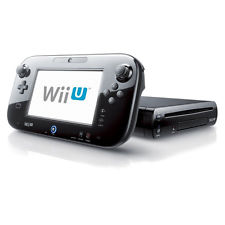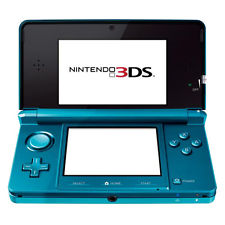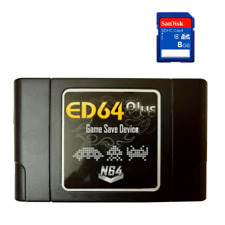|
April 7th, 2009, 11:11 Posted By: wraggster
Making sense of Nintendo before the success of the Wii.
With the wildly successful Nintendo DS and Wii hitting record sales month after month, Nintendo looks like a million bucks. All of Nintendo's well calculated strategies and inventive risks look like--and may very well be--genius.
Going against the grain of more sophisticated machines such as the Xbox 360 and PlayStation 3, in 2006 Nintendo launched the Wii, a console less powerful than the original Xbox, accompanied by an un-tried game controller that smacked of trickery, and a name that sounded so close to urine that it made everyone over 10 years of age giggle.
But it wasn't always that way.
For the last two generations, Nintendo's primary consoles landed second and third in the three-way leg races for console supremacy. The Nintendo 64 and the GameCube each had their moments in the sun--with Mario and Zelda blockbusters and several other big guns in regular intervals--but on the whole, those systems were not the kind of successes Nintendo or its fans were used to--or expected. Nintendo 64 and GameCube made money for Nintendo, but weren't as friendly or as attractive to third-party publishers. Nintendo's storage media proved less easy to use and stored less than competitors' media. And Nintendo, though it was trying, didn't have the means of distinguishing itself enough from its competitors.
1995: The Looming Next Generation Console War
I landed my first job in the game industry with Next Generation magazine in 1994. That was the year of the first big console wars, and the first time I heard about "Ultra 64," which later became Nintendo 64. With Sega having gained significant ground on the Super Nintendo in the 16-bit era due to the Genesis, this new "32-bit era" proved to be a much bigger, more competitive leg race. Nintendo's Herculean and nearly single-handed rebuilding of the game industry from ashes was now being challenged by a small selection of interesting potentials and an even bigger crop of potential vaporware carpetbaggers. Among the crop of consoles were the Atari Jaguar, SNK's Neo-Geo, the first Sony PlayStation, Sega Saturn and the Sega 32X, the CDI, and the 3DO.
If you wanted to simplify gamers and industry thinkers into two camps at the time on the subject of Nintendo, there were loyalists and detractors. The loyalists had been reared on and were delighted by Nintendo games during their youths, and they couldn't see how Nintendo could or would lose to anybody; taking second place wasn't part in the discussion. As it turns out, almost anyone who has played a Mario or Zelda game becomes a loyalist at some level.
But Sega was on the rise. Sonic was more popular than Mickey Mouse. And Sony's machine also had something powerful and exciting about it that wasn’t quite clear yet to anybody in 1995.
Nintendo was late entering in this new race. The Super NES was still chugging along just fine, and Nintendo had fought many battles to become the industry leader. In the US in 1993 the Atari Jaguar and 3DO launched (with weak results), while the Saturn and PlayStation would arrive by winter 1995. Nintendo's system also was originally slated for fall 2005. It was then pushed back to April 1996. And eventually it was pushed back again to be launched on September 29, 1996 in the US. I sat next to Editor-in-Chief Neil West at Next Generation in the Burlingame offices and remember regularly hearing him challenge various news publications and editors on the phone. With great confidence he always said, "Wait for Nintendo." Whether they liked it or not, everyone had to wait for the 800 pound gorilla to arrive, however slow it might be.
The Shoshinkai Exhibition: Brilliance or Bust?
That February 1996 issue of Next Generation, reporting all of the details from Nintendo's Shoshinkai exhibition and with Mario on the cover, was one of the best-selling issues of the magazine during its short life-span. The cover headline read: "Nintendo's Ultra 64, Mario's Brave New 3D World." which ran in maroon and white; and along with it was a strange, strange cover image.
You could make out a multi-tiered ledge on the left, and behind that was an immense blue, cloud-filled sky. From the ledge leapt a smiling, arms-stretched-wide Mario, overalls, white gloves, and red hat in tow. Was he leaping off the ledge or flying past it? What was he doing? Next Gen art designer Richard Szeto had to create the entire cover from scratch, including the cover model of Mario, because Nintendo had provided nothing but screenshots (of Mario's backside), none of which could be used for the cover.
That issue realistically pointed out that Nintendo was still holding its cards close its chest, avoiding issues about the "Bulky Drive" and giving out worrying signs. Ten playable games had been promised at the show, but only two were actually playable. What was worse? "With only three seconds of videotaped, non-interactive 'game footage' on display, one needn't be cynical to work out why these games weren't available," the cover story stated. Nintendo wasn't ready to show its or its partners' games yet.
The Ultra 64 showed up in glass cases, and Next Gen cited Kirby 64 as only "one half of a game," as it was barely playable. But 18 games were previewed in the issue, Nintendo's Shigeru Miyamoto was interviewed, and George Zachary of Silicon Graphics was quizzed about the game's powerful MIPS 64-bit RISC CPU, the "Reality Co-Processor," and the immense level of secrecy around the chips' development.
"…We had to deliberately cut down the level of communication internally [at Silicon Graphics]. No one knew were the Ultra 64 lab was. We had a whole lab of Ultra 64 stuff and 70 people working on the CPU alone--with a big Donkey Kong Country poster on the window so no one could see in!" Zachary said.
What Next Generation Magazine came home with was 11 previews of mostly first-party games for Ultra 64. (I kept the original names in these lists.) Those previews included Super Mario 64, Kirby Bowl 64, Legend of Zelda, PilotWings 64, Star Wars: Shadows of the Empire, Super Mario Kart R, Wave Racer, StarFox 64, Body Harvest, Buggy Boogie, and Golden Eye 007.
Nintendo listed 38 games that were in development for the system (seen here with publisher and developer in parentheses). Those included:
Ace Driver (Namco)
Alien Trilogy (Acclaim)
Blast Dozer (Nintendo/Rare)
Body Harvest (Nintendo, DMA Design)
Buggie-Boogie (Nintendo/Angel Studios)
Creator (Nintendo/Software Creations)
Cruis'n USA (Nintendo/Williams)
Dragon Quest VII (Enix)
FIFA Soccer '97 (EA)
Final Fantasy VII (Squaresoft)
Frank Thomas Big Hurt Baseball (Acclaim)
GoldenEye 007 (Nintendo/Rare)
John Madden Football (EA)
Ken Griffey, Jr. Baseball (Nintendo)
Killer Instinct 2 (Nintendo/Rare)
Kirby Bowl 64 (Nintendo)
Mission: Impossible (Ocean)
Monster Dunk (Mindscape)
Mortal Kombat 3 (Williams)
Phear (Nintendo/H2O)
PilotWings 64 (Nintendo)
Prey (Apogee/3D Realms)
Quake (id Software)
Red Baron (Sierra Online)
Robotech Academy (Gametek)
Star Wars: Shadows of the Empire (LucasArts)
Soul Storm (Virtual Hollywood)
Stacker (Virgin)
Starfox 64 (Nintendo)
Super Mario 64 (Nintendo)
Super Mario Kart R (Nintendo)
The Legend of Zelda (Nintendo)
Top Gun (Spectrum Holobyte)
Turok: Dinosaur Hunter (Acclaim)
Ultra Doom (id Software)
Ultra FX Fighter (GTE)
Wave Race 64 (Nintendo)
Wayne Gretzky Hockey (Time Warner)
A total of 14 games, nearly one half of those listed above, never saw store shelves.
Nintendo's Revolutionary Steps
Less than one year later, the Nintendo 64 launched on September 29, 1996 with only two launch titles, Super Mario 64 and PilotWings 64. From September 29 to December 31, the system saw a steady trickle of games that included Cruis'n USA, Killer Instinct Gold, Mortal Kombat Trilogy, Wayne Gretzky's 3D Hockey, and Star Wars: Shadows of the Empire.
Fans of Nintendo stood by, exhilarated and frustrated. They occasionally paid extra for their games (Turok: Dinosaur Hunter's original MSRP was $79.99), suffered delay after delay for first- and third-party games (Mario Kart, Star Fox, GoldenEye 007), and watched as less than impressive games shipped from Nintendo's so-called Dream Team of Acclaim, Midway, Virgin, Angel Studios, LucasArts, and a few others.
The real Dream Team was Shigeru Miyamoto himself. Super Mario 64 was brilliant, stunning, unbelievable. If ever a game deserved endless layers of praise and hype, this was it. Everything else paled in comparison.
"I was more or less trying to be objective while desperately hiding my fanboy optimism," said Mike Mika, currently head of development at Other Ocean, and then soon-to-be associate editor at Next Generation. "The images we had seen of Mario 64 from Japan were unprecedented. Remember, around this time we had Tomb Raider looming but not released. Mario 64 was the first truly third-person 3D game of its kind. It felt like the lock had been opened, the chains removed, and you could do anything in the game. It wasn’t until GTAIII that I felt anything remotely like it again. Tomb Raider was close, but it still felt constrained. The contrast of Mario’s blue horizons and gigantic landscapes to Tomb Raider’s claustrophobic environment was pretty big. PilotWings 64 was simply a fanboy curiosity compared to Mario. Overall, it felt like the launch of the Super Nintendo – it was a jolt of nostalgia."
Miyamoto's first big foray into 3D was, and still is, a masterpiece of the imagination. It's also one of the best 3D re-visions of an old 2D franchise to date. Super Mario 64 instantly became the definitive 3D platformer; and in one shot, Miyamoto and his team approached, grappled with, and solved nearly all of the 3D camera and geometrical issues that dozens of other publishers, years after, would continue to try and solve in their games.
"I think there were a lot of worried people before N64 launched that were sort of swept away by just how stunning Mario 64 was!" said Chris Charla, currently the VP of business development at Foundation 9 Entertainment, and former editor-in-chief of IGN and Next Generation. "It's hard to even remember now just how revolutionary it was at the time, the first really well done 3D platformer. Nintendo solved so many fundamental 3D issues with that game, and it was just tuned to perfection. Plus it had (at the time) just these incredible draw distances. Overall, the impression when the game launched was just that we were stunned."
Following Super Mario 64 in 1996, it became clear that Nintendo's first-party games were the games one had to have. Nintendo's Mario Kart 64 and StarFox 64 delighted all of Nintendo's fans, but not all of its detractors. Wave Race 64, which was originally called Wave Racer and featured high-powered jet boats, was underrated and underappreciated on the large scale, but was years ahead of its time, delivering superb water physics and never-seen-before jetski races. (Wave Race 64 was the first game to give us the lens flare.).
"Wave Race just did things that no other system did in terms of looks, with its ultra-real water, and the wave action lent a totally new action to racing," said Charla.
Then came Rare's GoldenEye 007, which had seen multiple delays and, on the surface, wasn't expected to be any good because it was a movie licensed title. But in August 1997 GoldenEye 007 arrived and became one of the biggest hits on the system, continuing on the sales charts well after it was supposed to drop off. GoldenEye 007 showed the world that first-person shooters could be really, really good on consoles.
"[GoldenEye 007] was the game that changed my opinion about first-person shooters on consoles," explained Mika. "I’ve clocked in more time on the multiplayer in that game with my friends than probably all of the time I’ve spent with games combined. Well into the PS2 lifecycle I was still finding time to play the game with some friends. It’s hard to believe now looking at it, but it was and remains one of the most amazing game experiences of my career."
Perhaps the most important release on Nintendo 64 was the annually delayed Legend of Zelda: Ocarina of Time. In the same way that Super Mario 64 was revolutionary for 3D games and platfomers, Ocarina of Time was revolutionary for pretty much everything else: game design, story-telling, the adventure genre, menu design, music integration, and, of course, 3D gameplay.
"Zelda... Zelda is Zelda!" exclaimed Charla. "It's one of the few games that not only lived up to the hype, it exceeded it! We [Next Generation magazine] called it 'Game of the Century' back in '98, and we took a lot of flack, but the reality is, it was. Edge Magazine just called it the best game of all time--even standing up against everything on the PS2 and current generation--so I think our call was validated!"
"Legend of Zelda: Ocarina of Time, hands down," said Mika when asked his favorite Nintendo 64 game. "Next Gen printed an exclusive issue for E3 the year of its release, with a bold golden cartridge on the cover. I have two issues signed by Miyamoto, one also has [Konami's Hideo] Kojima and a bunch of other game designers who happily paid tribute. The game was completely immersive. What Mario 64 did for Super Mario, Ocarina went 10 times farther. The haunting melodies of the ocarina still resonate with me."
So what happened? Why did Square and Enix, long-time Nintendo loyalists, switch to Sony's PlayStation? What happened to the "Bulky Drive?" How did Nintendo's cartridge-based system end up driving away third-parties away? Why did Sony take the console crown?
http://www.edge-online.com/blogs/loo...os-fall-part-1
For more information and downloads, click here!
 There are 0 comments - Join In and Discuss Here There are 0 comments - Join In and Discuss Here
|
|
 NES
NES










